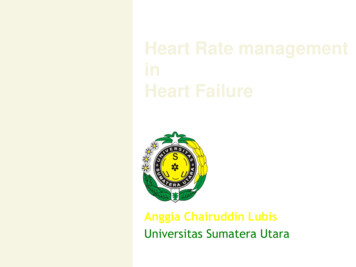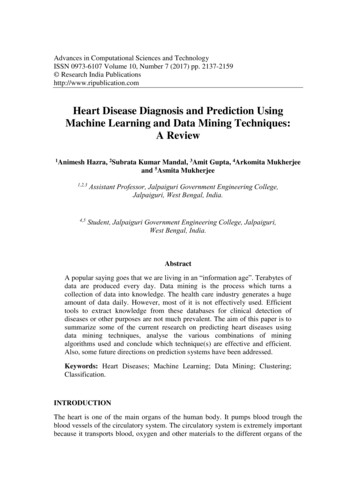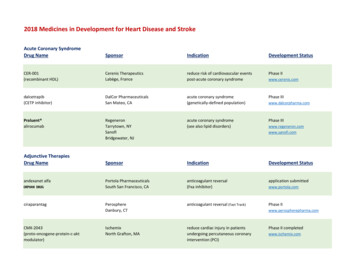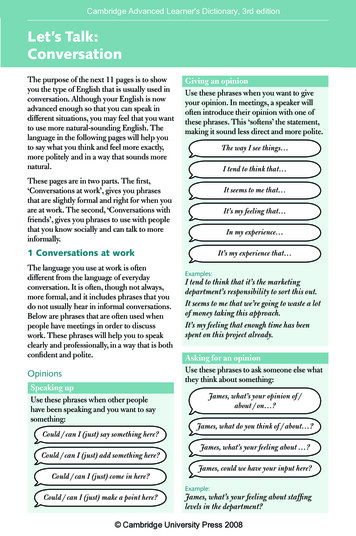
Transcription
Jazz Chants. . . how to use them to help your students speak moreclearly, practice vocabulary, and learn and reinforcegrammar patterns.Shirley ThompsonESL Consultant, Teacher Trainer
Goals for this webinar: to introduce (or re-introduce) you to CarolynGraham’s Jazz Chants. to show you how I introduce and practice chants inmy classes to explore a variety of ways you can use jazz chants– to help your students speak with the natural rhythm andintonation patterns of American English– to practice vocabulary– to introduce and reinforce grammar patterns
What are Jazz Chants?“Jazz Chants are Carolyn Graham's snappy,upbeat chants and poems that use jazzrhythms to illustrate the natural stress andintonation patterns of conversationalAmerican English.”[from Oxford University Press]
Let’s listen to Carolyn Grahamtell how jazz chantswere born.
Carolyn Graham: “A jazz chant is really just spoken AmericanEnglish with an awareness of the natural rhythms.” Chants use natural spoken English Chants can be used in classes of any sizeChants don’t require any special materialsChants can be used with all age groupsChants do not require musical ability
Let’s begin with the simplest of chants.Listen first. Then we’ll practice.Hi, how are you?12Fine, how are you.34
Advice from Carolyn Graham. . . A jazz chant has a four-beat rhythm: 1, 2, 3, 4, Each beat will be either a stressed word (orsyllable) or clap (or tap or pause) The first beat is the first stressed word, whichmay not be the first word.Example: Do you like it? (clap) Yes, I do.123 4
Why is this focus on stress, rhythm, andgrouping so useful?For native English speakers, stress is key tomeaning. It’s what we listen for to know what’simportant and what to focus on.Jazz chants are a fun, practical way to helpstudents begin to notice and produce naturalrhythm.
SYLLABLE-TIMED VS. STRESS-TIMEDMany languages are “syllable-timed”-- every syllablegets more or less the same stress or emphasis.ed u ca ti on 5 staccato beatspa pa 2 even, staccato beats, same vowel sound in bothBUT NOT ENGLISH. . .English is a “stress-timed”language.The rhythm is based on stressed words and syllables,not all syllables.ed u CA tion 1 strong beatPA pa 1 strong beat
Rhythm in SentencesHow many syllables? How many stresses?Kids play ball.3 syllables/3 stresses 3 beatsThe kids play ball.4 syllables/3 stresses 3 beatsThe kids are playing ball.6 syllables/3 stresses 3 beatsThe kids are playing with the ball.8 syllables/3 stresses 3 beatsThe kids have been playing with the ball.9 syllables/ 3 stresses 3 beats
The beat is set by the number of stresses, NOT the number ofsyllables. So, each line takes approximately the SAME amount oftime to say. Let’s try it.Kids play ball.1 23 (clap 4)The kids play ball.The kids are playing ball.The kids are playing with the ball.The kids have been playing with the ball.
The many levels of STRESS Words with two or more syllables will always have oneprimary stress. photograph, photographer, photographic Phrases have stress. an excellent photographer (unstressed, stressed, focus stress) Sentences have stress patterns. My grandmother was an excellent photographer. We use stress to focus attention and show contrast, oftento correct, contradict or disagree.– My father liked to paint, but my mother was a photographer.– She was a photographer not a photojournalist.
Stress in English impacts meaning.(Other languages have stress, but often it doesn’t changethe meaning.)Word-level: REcord vs. reCORDYears ago, I was teaching a speaking & listening class.After class, a student approached me with his cassettetape in his hand. . .Student: I need to talk to you about my cassette.Me: Do I know your cousin?I misunderstood because the stress was incorrect even though heused the correct word.
Stress affects meaning at the phrase and sentence level.A conversation in a bakery:Customer: I’d like two large muffins, please.Server: Here you are.Can you guess what the problem is in each case?1. Customer: Excuse me, I asked for two large muffins.2. Customer: Excuse me, I asked for two large muffins.3. Customer: Excuse me, I asked for two large muffins.
Regular focus on stress andrhythm will train your students toNOTICE stress in English – even ifthey don’t always get it right, atleast they’ll be learning to listenfor it!
Some general suggestions for using Jazz Chants:Begin ORALLY. This forces students to listen towhat you actually say and not what they thinkwords should sound like based on the waythings are spelled.Be dramatic. Exaggerate and make it fun.Have students listen to the whole chant first.Then have them listen and repeat each lineseveral times together as a chorus.
How I teach jazz chants. . .1. Introduce the chant orally first. Explain any idioms.Discuss the context.2. Begin with group (choral) practice. Then move to pairand individual practice.3. Focus on stress, thought groups, and intonation.4. For longer, more complex chants, after some oralpractice, (group and pairs) show them the writtenchant. Go through it again several times.5. Together, mark it to show major stresses, intonation,reduced sounds, linking and blending. [Visual learnerswill appreciate this!]6. Review chants regularly! They make great warm-ups.
Do you like it? Do you like it? (clap) Yes, I do.123 4Does he like it? (clap) Yes, he does.Does she like it? (clap) Yes, she does.Do they like it? (clap) No, they don’t.No, they don’t. No, they don’t.
Do you like it?1234Do you like it? (clap) Yes, I do.Does he like it? (clap) Yes, he does.Does sheit? (clap) Yes, she does.Do they like it? (clap) No, they don’t.No, they don’t. No, they don’t. (all together)
How stress works in sentences. . . content words are usually stressed - nouns, main verbs,adjectives, adverbs, demonstratives (this, these, those)and negatives (can’t, won’t, never, no, etc.) function words are usually unstressed and reduced - a,an, the, pronouns, auxiliary verbs, most prepositions, etc. in unstressed words and in unstressed syllables, thevowel sounds are reduced and often move to “schwa”:“Do you like it?” do and you are reduced typically the last content word in each thought groupreceives the most stress:I put the groceries/ in the bag / on the counter.
Two groups: A – questions; B – answers.Last line all together.What do you wear on your head? A hat.1234What do you wear on your hands? Gloves.1234What do you wear on your feet? Socks.1234Shoes and socks, shoes and socks. (all together)1234
Do you think it’s going to rain?(first verse)Do you think it’s going to rain?I hope not.Do you think it’s going to rain?I hope not.It looks like rain.It looks like rain.Do you think it’s going to rain?I hope not.(from Small Talk)
It Was Raining When She Saw HimIt was raining when she saw him.It was raining when they met.It was pouring when they fell in love,the streets were dark and wet.It was raining when they parted.There were dark clouds in the sky.It was raining when he left her,when he turned and said “Good-bye.”
Here’s another case where you could mark therhythm in at least two different ways.12It was raining when she saw him.34It was raining when they met.1234It was raining when she saw him. (clap)1234It was raining when they met. (clap)
An easy jazz chant. Jazz chants can provide students with useful “chunks” of language –expressions they learn as a whole rather than word-by-word. Carolyn Graham’s chant, How do you spell “dog”? gives student a“template” for asking how to spell a word. Try beating out the rhythm by marching. You can have students marchin a circle as they chant. It gets the rhythm of English into their bodies.(It’s specially great for kinesthetic learners.)How do you spell dog? (clap, tap, or snap)d-o-g (clap/tap)How do you spell cat? (clap/tap)c-a-t (clap/tap)How do you spell octopus? (clap/tap)Don’t ask me! (clap/tap)
In grammar classes. . . Whenever possible, introduce grammar points orally. Jazzchants are a fun and memorable way to do this. Focus on the individual sounds that matter most in English –sounds that indicate grammatical features such as thirdperson singular, plural or tenses. For example:/s/,/z/, /t/ /d/, and /Id/.
Here’s a jazz chant called “The Hungry Boy Chant.”He wants:One egg, two bananas,Three hotdogs, four hamburgers,Five cookies, six sandwiches,(clap) He’s a hungry boy! (clap)This provides practice with plural endings.You can also use it to teach students to notice how stress changes to expressdifferent meanings. Make true and false statements and have studentscorrect you. Or ask questions. Example: You: He ate three eggs. Student: No, he ate three hotdogs. You: He ate three bananas. Student: No, he ate two bananas. You: Did he eat three sandwiches? No, he ate six sandwiches.
Grammarchant: Irregular Verbsfrom Grammar Chants by Carolyn GrahamSay, said.Stop on red.Eat, ate.Don’t be late.Break, broke.Have a coke.Take, took.Learn to cook.Speak, spoke.Tell a joke.Write, wrote.Get off the boat!
Chants can be used to teach or reinforce grammar points while at thesame time providing speaking & pronunciation practice.Student can quite easily absorb complex grammar points through thistype of quality repetition.IF IT RAINS I’LL WEAR MY RAINCOAT BY CAROLYN GRAHAMIf it rains / I’ll wear my raincoat. (clap)If it doesn’t rain / I won’t. (clap)When it’s cold / I always wear my gloves.When it isn’t cold, / I don’t. (clap)If it snows I won’t wear sandals* (clap)If the sun comes out I will. (clap)But if it rains I’ll wear my brand new coat.*If I don’t I’ll get a chill. (clap)*When three content words appear in a row, we typically alternate thestress.
Habits (excerpt)Bob gets up at six o’clock.He never wakes up late. (clap)He always gets up early. (clap)He never sleeps till eight. (clap)He always drinks his coffee black.He never uses cream. (clap).(from Grammarchants)
What’s Going on This Morning?The earth is turning,The toast is burning,The water is boiling,The tea kettle’s whistling,The faucet is leaking,(etc.)
More grammar with Jazz ChantsFor this activity, give the students the written version of thechant before they hear it. See if they can apply the rules ofstress. At the same time, they’re reviewing parts of speech. Have students identify all of the nouns, adjectives,adverbs and other content words that will mostlikely be stressed when you’re going to do a chant.Underline the stressed words. Then have them identify the function words thatwill be reduced. Draw a line through theunstressed words. Let’s try it.
Is the Post Office Open Tomorrow?(excerpt from Jazz Chants by Carolyn Graham)Is the post office* open tomorrow?It’s open from nine to five.Is the post office open tomorrow?It’s open from nine to five.What time does it open?It opens at nine.What time does it close?It closes at five.It opens at nine and closes at five.It’s open from nine to five.Note: post office is a compound or set phrase and has one primary stress.
Is the Post Office Open Tomorrow?(excerpt from Jazz Chants by Carolyn Graham)Is the post office* open tomorrow? rising intonationIt’s open from nine to five.Is the post office open tomorrow?It’s open from nine to five.What time does it open? falling intonationIt opens at nine.What time does it close?It closes at five.It opens at nine and closes at five.It’s open from nine to five.Note: post office is a compound or set phrase and has one primary stress.
Writing your own chants. . .The language should be real useful appropriate for the levelLet’s begin with vocabulary chants.1.2.3.Why vocabulary chants? Rhythm is a powerful tool for memory.Have students make a list of vocabulary words from a lesson you’vedone.Ask them to arrange them according to the number of syllables perword.Choose a two syllable, a three syllable and a one syllable word tomake a chant.
An example from Carolyn Graham(you can see her perform this on the video)ruler (2 syllables)eraser (3 syllables)chair (1 syllable)The chant:1234ruler eraser chair (clap)ruler eraser chair (clap)ruler eraser ruler eraserruler eraser chair (clap)
Make it more complex by adding adjectives.1234purple ruler pink eraser1234purple ruler pink eraser1234purple ruler pink eraser1234yellow chair yellow chair
Vocabulary: places is my townWORD LISTdrugstoretrain stationbead shopbookstorehardware storezoopost officemallONE SYLLABLEzoomallTWO SYLLABLESdrugstorebead shopbookstoreTHREE SYLLABLEStrain stationpost officehardware storeTHE CHANT:drug storetrain stationzoo[clap](repeat)
More vocabulary chants – just for fun (usingthe 2 – 3 – 1 pattern):Words to praise someone’s work:perfect (2 syllables)fabulous (3 syllables)great (1 syllable)The chant:perfect, fabulous, great (clap)perfect, fabulous, great (clap)perfect, fabulous, perfect, fabulousperfect, fabulous, great (clap)
Writing your own chants. . .Once you feel comfortable using jazz chants,you may want to try writing your own.Start by listening to the rhythms thatnative speakers use.Remember, it should be: real language, useful, and appropriate for the age group. And keep it simple.
It’s best to listen to something natural andunscripted as a model. Try National PublicRadio,www.npr.org and click on Storycorps. You’ll hearAmerican telling stories about their lives usingnatural language.Recordings are great because you can listen tothem again and again until you hear therhythm.
Let’s recap. . . the many uses of jazzchants Use jazz chants to reinforce and practicevocabulary. Rhythm is a powerful memorytool. [ruler, eraser, chair] Use jazz chants to practice idiomaticexpressions and “chunks” of useful language.[How do you spell ? Do you think it’s goingto rain? I hope so. I hope not.]
Use jazz chants to practice grammar patterns andfeatures.[If it I’ll (future). vs When it I (simplepresent).; Do you . . ? Does he. . .? ] Use jazz chants to help your students learn andpractice producing the natural rhythms of spokenEnglish. [Hi. How are you?] If your students are shy and a bit timid aboutspeaking English, use jazz chants to help thembuild confidence.
Thank you for joining this webinar!I hope you’ll have fun with these chants!
The many levels of STRESS Words with two or more syllables will always have one primary stress. photograph, photographer, photographic Phrases have stress. an excellent photographer (unstressed, stressed, focus stress) Sentences have stress patterns.











